Deconstructing Survivin: comprehensive genetic analysis of Survivin function by conditional knockout in a vertebrate cell line
- PMID: 18936249
- PMCID: PMC2568024
- DOI: 10.1083/jcb.200806118
Deconstructing Survivin: comprehensive genetic analysis of Survivin function by conditional knockout in a vertebrate cell line
Abstract
Survivin is a key cellular protein thought to function in apoptotic regulation, mitotic progression, or possibly both. In this study, we describe the isolation of two conditional knockouts of the survivin gene in chicken DT40 cells. DT40 cells lacking Survivin die in interphase after failing to complete cytokinesis. However, these cells show normal sensitivity to the chemotherapeutic agent etoposide. Expression of Survivin mutants against a null background to reassess the role of several key residues reveals that DT40 cells can grow normally if their sole Survivin is missing a widely studied cyclin-dependent kinase phosphorylation site or sites reportedly essential for binding to Smac or aurora B. Mutations in the nuclear export sequence or dimerization interface render cells temperature sensitive for growth. As an important caveat for other studies in which protein function is studied by transient transfection, three of the Survivin mutants fail to localize in the presence of the wild-type protein but do localize and indeed support life in its absence.
Figures
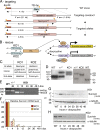
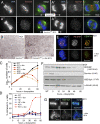
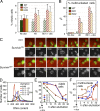
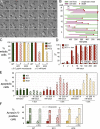
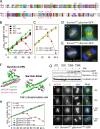
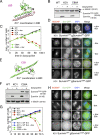
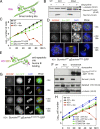
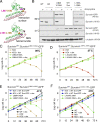
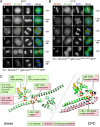
Similar articles
-
Gradient of increasing Aurora B kinase activity is required for cells to execute mitosis.J Biol Chem. 2010 Dec 17;285(51):40163-70. doi: 10.1074/jbc.M110.181545. Epub 2010 Oct 18. J Biol Chem. 2010. PMID: 20956539 Free PMC article.
-
Histone H3 Thr-3 phosphorylation by Haspin positions Aurora B at centromeres in mitosis.Science. 2010 Oct 8;330(6001):231-5. doi: 10.1126/science.1189435. Epub 2010 Aug 12. Science. 2010. PMID: 20705812 Free PMC article.
-
Exploring the functional interactions between Aurora B, INCENP, and survivin in mitosis.Mol Biol Cell. 2003 Aug;14(8):3325-41. doi: 10.1091/mbc.e02-11-0769. Epub 2003 May 29. Mol Biol Cell. 2003. PMID: 12925766 Free PMC article.
-
The survivin/Aurora B complex: its role in coordinating tension and attachment.Cell Cycle. 2003 Nov-Dec;2(6):507-10. doi: 10.4161/cc.2.6.559. Cell Cycle. 2003. PMID: 14504461 Review.
-
Chromosomal passengers and the (aurora) ABCs of mitosis.Trends Cell Biol. 2001 Feb;11(2):49-54. doi: 10.1016/s0962-8924(00)01880-8. Trends Cell Biol. 2001. PMID: 11166196 Review.
Cited by
-
Temporal and spatial regulation of translation in the mammalian oocyte via the mTOR-eIF4F pathway.Nat Commun. 2015 Jan 28;6:6078. doi: 10.1038/ncomms7078. Nat Commun. 2015. PMID: 25629602 Free PMC article.
-
Loss of Survivin influences liver regeneration and is associated with impaired Aurora B function.Cell Death Differ. 2013 Jun;20(6):834-44. doi: 10.1038/cdd.2013.20. Epub 2013 Mar 22. Cell Death Differ. 2013. PMID: 23519077 Free PMC article.
-
Making the Auroras glow: regulation of Aurora A and B kinase function by interacting proteins.Curr Opin Cell Biol. 2009 Dec;21(6):796-805. doi: 10.1016/j.ceb.2009.09.008. Curr Opin Cell Biol. 2009. PMID: 19836940 Free PMC article. Review.
-
The Nup107-160 nucleoporin complex promotes mitotic events via control of the localization state of the chromosome passenger complex.Mol Biol Cell. 2009 Dec;20(24):5260-75. doi: 10.1091/mbc.e09-05-0377. Mol Biol Cell. 2009. PMID: 19864462 Free PMC article.
-
Survivin reads phosphorylated histone H3 threonine 3 to activate the mitotic kinase Aurora B.Science. 2010 Oct 8;330(6001):235-9. doi: 10.1126/science.1189505. Epub 2010 Aug 12. Science. 2010. PMID: 20705815 Free PMC article.
References
-
- Adams, R.R., S.P. Wheatley, A.M. Gouldsworthy, S.E. Kandels-Lewis, M. Carmena, C. Smythe, D.L. Gerloff, and W.C. Earnshaw. 2000. INCENP binds the Aurora-related kinase AIRK2 and is required to target it to chromosomes, the central spindle and cleavage furrow. Curr. Biol. 10:1075–1078. - PubMed
-
- Altieri, D.C. 2006. The case for survivin as a regulator of microtubule dynamics and cell-death decisions. Curr. Opin. Cell Biol. 18:609–615. - PubMed
-
- Ambrosini, G., C. Adida, and D.C. Altieri. 1997. A novel anti-apoptosis gene, survivin, expressed in cancer and lymphoma. Nat. Med. 3:917–921. - PubMed
-
- Ambrosini, G., C. Adida, G. Sirugo, and D.C. Altieri. 1998. Induction of apoptosis and inhibition of cell proliferation by survivin gene targeting. J. Biol. Chem. 273:11177–11182. - PubMed
Publication types
MeSH terms
Substances
Grants and funding
LinkOut - more resources
Full Text Sources
Other Literature Sources
Research Materials

